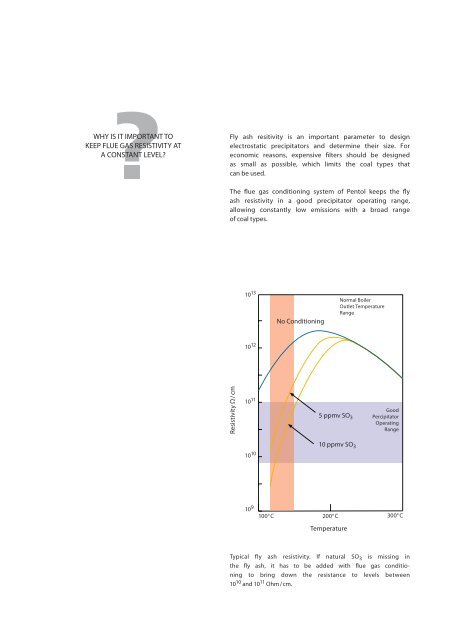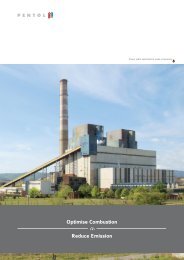FLUE GAS CONDITIONING
Increase ESP Efficiency Reduce Solid Emission Increase Whiteness of Gypsum
Increase ESP Efficiency
Reduce Solid Emission
Increase Whiteness of Gypsum
You also want an ePaper? Increase the reach of your titles
YUMPU automatically turns print PDFs into web optimized ePapers that Google loves.
WHY IS IT IMPORTANT TO<br />
KEEP <strong>FLUE</strong> <strong>GAS</strong> RESISTIVITY AT<br />
A CONSTANT LEVEL?<br />
Fly ash resitivity is an important parameter to design<br />
electrostatic precipitators and determine their size. For<br />
economic reasons, expensive filters should be designed<br />
as small as possible, which limits the coal types that<br />
can be used.<br />
The flue gas conditioning system of Pentol keeps the fly<br />
ash resistivity in a good precipitator operating range,<br />
allowing constantly low emissions with a broad range<br />
of coal types.<br />
10 13<br />
No Conditioning<br />
Normal Boiler<br />
Outlet Temperature<br />
Range<br />
10 12<br />
Resistivity Ω / cm<br />
10 11<br />
5 ppmv SO 3<br />
Good<br />
Percipitator<br />
Operating<br />
Range<br />
10 10<br />
10 ppmv SO 3<br />
300° C<br />
10 9<br />
100° C<br />
200° C<br />
Temperature<br />
Typical fly ash resistivity. If natural SO 3 is missing in<br />
the fly ash, it has to be added with flue gas conditioning<br />
to bring down the resistance to levels between<br />
10 10 and 10 11 Ohm / cm.




